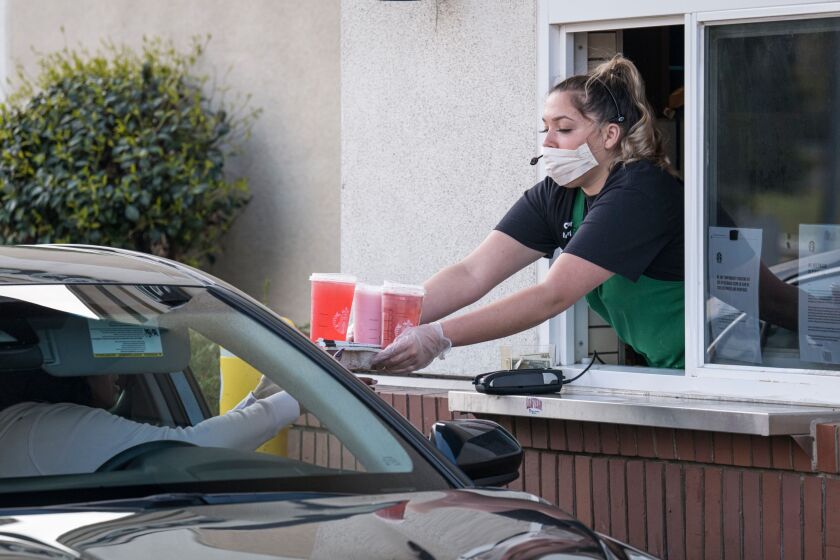The businesses that are open now are providing clues for payment hardware makers on how the retail landscape will look once the pandemic clears.
In the U.S., quick-serve restaurants and supermarkets are among the limited business categories that are widely open, though under distinct circumstances. Supermarkets are placing tape barriers six feet apart to keep shoppers away from each other in checkout lines, and are placing more of an emphasis on self-checkout.
In Asia, where the coronavirus struck first, stores have begun learning what it takes to bring shoppers back out in public.
The companies that make point of sale technology are already seeing a shift in demand — and any hardware purchased during the pandemic will likely remain in place long after.
“You’re going to see ordering kiosks getting used a lot more, even though they’re mostly used at quick serve restaurants,” said Lynn Beattie, strategy director for Diebold Nixdorf.

Diebold Nixdorf has added more cloud-based technology to make point of sale apps in stores more flexible to support contactless payments and to integrate payment acceptance with incentive marketing. The technology was added to compete with checkout-free technology companies pursuing the Amazon Go model and fintechs such as Square.
As Diebold Nixdorf restructures to shore up its finances, a degree of flexibility will be necessary to keep the company relevant as stores manage new traffic patterns.
A majority of middle-market CFOs are predicting an economic recovery and revenue increases for their companies in 2021, according to a new survey by BDO USA.
Tax-refund delays and stimulus-payment hiccups could spill into the upcoming tax season as the Internal Revenue Service continues to face challenges related to the coronavirus pandemic and as Congress considers yet another round of direct payments.
With the filing season upon us, a raft of brand new challenges await ahead of the April 15 deadline.
By adding ordering kiosks to more merchant categories, Diebold Nixdorf hopes to accommodate less interaction with store staff and more efficient shopping. That will combine with mobile checkout, or store staff scanning items while consumers are shopping, to reduce strain at the front of the store.
It’s a step that will come initially at supermarkets, Beattie said. Supermarkets are shortening hours, and a mix of public policy and consumer behavior changes have resulted in people going to supermarkets much less. That combination, plus the long lines to enforce distancing, has conversely resulted in larger transaction times and cart sizes at the point of sale.
Adding more self-service kiosks and incremental product scans are a way to mitigate that crowding. “There are also other benefits to doing scans throughout the store,” Beattie said. “Shoppers can keep track of what they are buying incrementally to see if it fits into their budgets. And self-checkout also allows store staff to be redeployed.”
Another group of payment executives recently told PaymentSource many merchant categories aren’t prepared for mature omnichannel shopping and payments. This strategy has existed for several years as a way for traditional retailers to respond to Amazon by personalizing shopping and marketing. Omnichannel is now being put to work as a way to shorten checkout times, Beattie said. The result will be that technology designs for grocery stores and quick-serve restaurants will wind up in furniture and clothing retailers.
“Non-food retailers will think more about how to change their customer journeys,” Beattie said.
Asian roadmap
Asian retail may also provide a clue. Stores in China are among the first to reopen after lockdowns.
“Consumers are shopping more online and in apps than in-store — especially in the categories of health products, daily essentials, groceries, kitchen tools and electronics relevant for home office,” said Nathan Salisbury, general manager of Ingenico ePayments in Asia Pacific.
Both Salisbury and Beattie mentioned cashless and contactless payments as key to store reopenings. This trend is becoming more prominent with the outbreak of COVID-19, as regulators attempt to slow the spread of the virus by limiting cash-based and in-person payments, Salisbury said, adding the Bank of Korea introduced a quarantine policy for cash banknotes and in India, the Reserve Bank encourages the use of nationwide digital payment methods.
There are also lessons from China that go deeper into the past, as earlier disease outbreaks such as SARS in 2003 played a role in expediting Alibaba’s aggressive digital shopping and payments strategies.
Starbucks has additionally made China a large part of its store innovation, using China as a blueprint for technology it will deploy elsewhere, such as mobile order and delivery. Starbucks and McDonald’s are also supporting China’s pending digital currency, a move that would likely be replicated elsewhere.
“Over the past 15 years, China has developed a unique e-commerce ecosystem, where a couple of conglomerates cover most people’s social and financial lives,” Salisbury said. “These conglomerates allow consumers to do everything, from managing their budget and investments to ordering food delivery. It most certainly allows them to make payments digitally, simply and easily, with little effort or disruption to the customer’s buying experience.”






